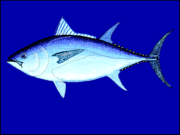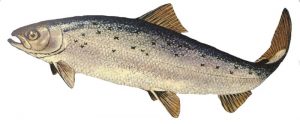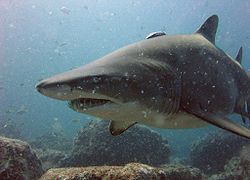Category Archives: Sea food
Hilton stops serving sailfish and marlin in Costa Rica
Four Hilton Worldwide hotels in Costa Rica have pledged to stop serving sailfish and marlin after entering into an agreement with the Billfish Foundation (TBF) and the Costa Rica Sport Fishing Federation (FECOPT).
Sharks On Coast Hunted For Soup
Hunters taking advantage of a Japanese delicacy are thought to be the reason that shark stocks have drastically declined off the Gold Coast beaches.
Some astounding numbers revealed yesterday that shark nets had reeled in forty less sharks in the past year, compared to the same time frame in 2001/02.
Trevor Long, director of marine sciences for Sea World, revealed last night that over fishing by thriteen commercial shark hunters in the area had led to the steep decline in the shark population.
It is common knowledge that hunters have been reeling in sharks to harvest their valuable shark fins, which are part of the “shark fin soup” craze sweeping Japan.
In the 2001-02 fiscal year, seventy-eight sharks were reeled in in nets off the Coast, however by 2009-10 that number had dropped to thirty-seven.
This year, between the months of January and September, twenty-five sharks have been reeled in in shark nets and drumlines.
The largest shark reeled in was an impressive three-point-nine meter male greater hammerhead and ten were over two meters long.
Mr Long has commented that the shark populations declining was not the world’s best thing for the health of the world’s oceans.
“If we didn’t have sharks the whole marine ecosystem would become unbalanced – they are the top of the food chain and ensure the survival of the fittest,” Mr Long explained.
“It’s a worrying trend that shark numbers all over the world are dropping.”
The big question is, is it worth making an entire species extinct to get a bowl full of an exotic soup? Some say yes, others say no, however the general consensus is that we should take the poor shark off our dinner menus, before it’s too late.
“Dog Salmon” Being Pushed Heavily in British Supermarkets as Christmas Meal

The sudden appearance of “chum salmon” has really shocked shoppers.
You see, farmed salmon – primarily Scottish in origin in years past – has gotten quite pricey, and the chum is the cheaper alternative, being twenty to thirty percent more economical.
A traditional salmon side of 600 grams may run you 10 GBP to 12 GBP, however this “dog salmon” retails for around 5 GBP.
However, it is not just this “dog salmon” which has been hitting the shelves. Many retailers are also opting for foreign bred geese as well, which has the National Farmers’ Union in an uproar.
“There is concern about how much food is coming in from overseas for Christmas – particularly when it’s dressed up as a traditional product and can quite easily be misleading,” fumed head of the NFU’s food chain unit, Lee Woodger.
“British farmers pride themselves on the quality of the food they produce, both in terms of the environmental and welfare standards, and traceability.
“Consumers can only get a 100 per cent guarantee on where food is farmed, produced and packaged if they see the tractor logo with a Union Jack on the packaging.”
That being said, the cheaper alternatives are sure to be the norm this Christmas, what with the current economic crisis the world over.
Case Study: BP Oil Spill Take Toll on Bluefin Tuna, Satellites Don’t Lie!

The amazing Atlantic bluefin tuna, some of the largest of this species of fish can be as large as a Volkswagon Beetle, make their way to the Gulf every year from January until June. The peak time when they spawn is about mid April to May – just as BP was giving out free samples of its precious oil, when the well they had exploded and started pumping thousands of gallons of crude into the area this past April 20th.
This fish, which is paramount to commercial markets everywhere, mate in the surface waters, the females lay their eggs and the males fertilize away behind them. The oil present could cause harm to the eggs, larva and even the adults in the area. To make matters worse, the Atlantic tuna populations of the world have seen a drastic decline of 82% over the past three decades, so it is extremely important that they be allowed to mate without interruption.
Well, great job BP.. You really did cause quite the disturbances… How would they like it if we dumped oil into their beds as they were getting in the mood?
Rather Strange Orange Lobster Saved From the Pot
So what exactly is so strange about an orange lobster? It’s actually living! Normally, lobsters are a brownish-green color when they are alive, and they turn orange when they have been cooked. That being the case, a strange live reddish-orange lobster has been sighted in the UK.
The lobster, which hails from North America, has been aptly named “Gumbo”. Gumbo is so rare that he was saved from becoming dinner, and was plunked down into a new home at the Birmingham National Sea Life Center.
Before making his way to the Sea Life Center, Gumbo was staying at the Natural History Museum I London. The museum was made aware of the rare find by fishmonger Rex Goldsmith. “I’ve never seen anything like it in 25 years in this business,” Rex commented.
Paul Clark, a crustacean researcher at the museum, was simply flabbergasted by extraordinary color of the carapace and agreed to aid Rex in finding a more suitable home for the lobster. “I was able to set up a saltwater tank here at the Museum to keep him alive until Sea Life agreed to take him and arrange collection.” Paul explained.
The shells of lobsters generally have red, yellow, and blue pigments which give them their brownish-green color when they are still alive.
The lobsters’ diet consists of shrimp, algae and other sea animals which contain cartenoid pigments.
These pigments are what give lobsters their color, and when they are cooked they break down and give them that “red” look.
Weird Yellow Colored Lobster Hauled in in R.I.
Denny Ingram reeled in a rather strange lobster in Narragansett Bay’s East Passage last week. It was peculiar indeed, this lobster you see, was gold colored on top, and bright yellow on its sides.
“I thought, holy cow, this is unusual. And no one else around here has ever seen anything like it either,” explained Ingram when asked to comment on the strange event.
They may be scarce, but they are not unheard of. This yellow coloring comes from a gene carried by both parents, and it makes itself apparent in roughly one out of every 30 million lobsters.
Slightly more common than these flashy yellow lobsters, are blue colored lobsters. The Audubon Education Center in Bristol has one of the blue little guys in its tidal pool. It replaced a previous blue occupant which was hauled in in 2003.
“The first blue lobster got too big — about a pound and three-quarters — so we released it back into the Bay,” explained director of the center, Anne Dimonti, “Now, we’re on our second one and it’s doing wonderfully.”
Ms. Dimonti has performed some research on these unusually colored lobsters and has found that estimates were all over the map as to how common they are. She explained that the estimates ranged from one in a million to one in 20 million. In her opinion, one in 4 million is the most commonly accepted figure.
“Being born a blue lobster is not so rare; what’s rare is surviving into adulthood as a blue lobster,” Dimonti explained. “When you’re a bright blue baby lobster walking around on the ocean bottom, somebody is going to pick you off very quickly.”
Japan Releases First Marine “Red List”
Greenpeace Japan has just recently released its “red list” this past 21st of July. This comprehensive little guide outlines the different endangered species which are currently being sold in supermarkets or served up in restaurants.
Greenpeace Japan has launched this “red list”, which is a ranking guide for seafood, in the hopes that it will force supermarkets in Japan to remove the endangered fish from their shelves, and stop selling them.
The Japanese version of this list contains around 15 different kinds of fish, including 5 different kinds of tuna which are very popular locally, which Greenpeace thinks shouldn’t be put on the shelves or in anyone’s frying pan. Research has shown that roughly 25 percent of the world’s tuna and 45 percent of the soon to be extinct Blue Fin Tuna is eaten by the Japanese. Greenpeace is hoping that by releasing this list will help to discourage consumers and retailers from eating the fish.
It should be noted that the fish on this list are those that Greenpeace thinks are susceptible to overfishing, are fished from rapidly depleting stocks, or are reeled in by using methods deemed to be damaging to ambient environments in the ocean and other fish species. The list for Japan includes Atlantic salmon, Bluefin Tuna, Greenland halibut, monkfish, red snapper and sharks. Greenpeace also has country specific lists and can be found on the corresponding Greenpeace website.
One has to ask… If it’s not OK for the Japanese to fish these “endangered fish” why is that same fish not on all the lists for the rest of the world???
Fishing Experts Claim: Shark Numbers Could Increase Drastically!
It has been warned that if a federal fishing ban along the east coast of Australia gets approved, then the sharks will go up in number exponentially, and the price of seafood will more than double.
This warning was issued yesterday by fishing experts and seafood industry veterans, during a firestorm of opposition to the establishment of the eight “no take” marine protection zones. These protection zones would also include a zone off of the Tweed Coast, stretching in commonwealth waters from Southern NSW to Torres Strait.
This idea was met with opposition by Paul Burt, a local fishing expert, as he warned that if fishing was banned in that particular area that more sharks would breed and head into those waters seeking the safety they offer..
“A lot of attacks that occur with sharks … occur where the marine parks are situated,” he began.
“The fish life flourishes so much that it does become an uncontrollable habitat.”[sic]
What winds up happening in these :”uncontrollable habitats” is that there will be an increase in the fish population, and this would lead to more sharks, he went on to explain.
Peter Peters, a seafood industry veteran, who also just happens to be the owner of Peter’s Fish Market located at Main Beach, has commented that imposing more limits on where commercial fishing boats can fish might make the prices of seafood skyrocket to the extent that it would be unaffordable for many ordinary Australians.
“I would say it would definitely double the price because the fishermen won’t be catching as much, their costs of traveling extra distances will go up and that will be passed on,” he explained.
Well, deliberation will continue, hopefully the outcome won’t rely solely on one side of the story…
Case Closed on Salmon Mystery Disease

The disease is caused by a previously unknown virus. This identification does not mean that there is now also a cure for the disease, however it is a great step forward into solving the problem. Now that scientists have pinned down the disease and the genome, it is only a matter of time before a cure will be found.
“It’s a new virus. And with this information now in hand, we can make vaccines,” explained director of Columbia Univerity’s Center for Infection and Immunity, Ian Lipkin.
A couple of years ago, some Norwegion fisheries got into touch with Lipkin and asked for his aid in discovering what was going on in their Norwegion Salmon farms. They wanted to know what was causing the HSMI (Heart and Skeletal Muscle inflammation), the scientific name for an affliction which was identified in 1999 on one of their farms.
The fish which are infected are physically stunted, and have muscles so weak that they often have trouble swimming about, or even circulating blood around their bodies. This disease often results in death, so there is a great cause or concern. The reason there is so much concern is that the original outbreak was followed by 417 other in Norway and the United Kingdom, and every year there are more reports of the disease.. What is even more disturbing is that there have been reports of wild salmon being infected, which means that salmon which escape the farm are infecting the already low numbers of wild stocks. If something is not done to fix this problem, it could quite possibly spiral out of control, and have a devastating effect on not only local ecosystems but on the entire salmon market as we know it. “If the potential hosts are in close proximity, it goes through them like wildfire,” said Lipkin.
Lipkin and his team, which have already had great success in identifying mystery viruses, rigorously examined samples taken from infected salmon pens. They were looking for the DNA sequences which resemble sequences found in other viruses, and hopefully finding the HSMI-causing sequence. Lipkin compared the grueling process akin to solving a Sunday paper crossword. The researchers eventually found what they were looking for, and dubbed the virus piscine reovirus, or PRV. The virus was unveiled and explained in the issue of Public Library of Science one, published on the 9th of July.
Some viruses which are rather similar have been discovered on poultry farms, and cause muscle and heart disease in chickens. “Analogies between commercial poultry production and Atlantic salmon aquaculture may be informative,” The researchers wrote in the article. “Both poultry production and aquaculture confine animals at high density in conditions that are conducive to transmission of infectious agents.”
The results from these investigations might just be useful when the Obama administration comes up with its national policy for regulating aquaculture.
Time to Move to Plan B For Asian Carp: FRY’EM!
The latest plan of action for getting rid of the Asian Carp (a very invasive species that could potentially throw the entire Great Lakes Ecosystem out of whack), comes from Governor Pat Quinn.
Illinois is going to be entering into a special deal with a Chinese meat processing company, known as Beijing Zhuochen Animal Husbandry Company and also with Big River Fisheries located in Pearl, Illinois, to remove 30 million pounds of this horrendous fish from Illinois rivers. Big River is in charge of processing, packaging and shipping the carp to Zhuochen, who will then resell it in international markets, where Asian Carp are considered quite a tasty dish. It is hoped that the company will be able to reel in at least 30 million pounds by the end of 2011.
“We believe the people of China who like to eat Asian carp will find this is the best anywhere on Earth,” Quinn boldly told the press earlier.
The environmentalists, who have been pulling their hair out since June when a Bighead Asian Carp was reeled in in Lake Calumet, were not at all impressed by the idea. They say that it is at best a way to buy time, and at worst a tactic which will kill the fishing industry.
“Many communities have been robbed of their ability to use and fish on the Illinois River by the slow response to limit the Asian carp’s infestation,” explains Henry Henderson, the Natural Resources Defense Council Midwest Director, “Governor Quinn’s announcement will be welcome news for people in places like Peoria, where it might help them get their river back. But our goal for the Illinois River should be to eradicate this dangerous invasive species, not manage a fishery.”



